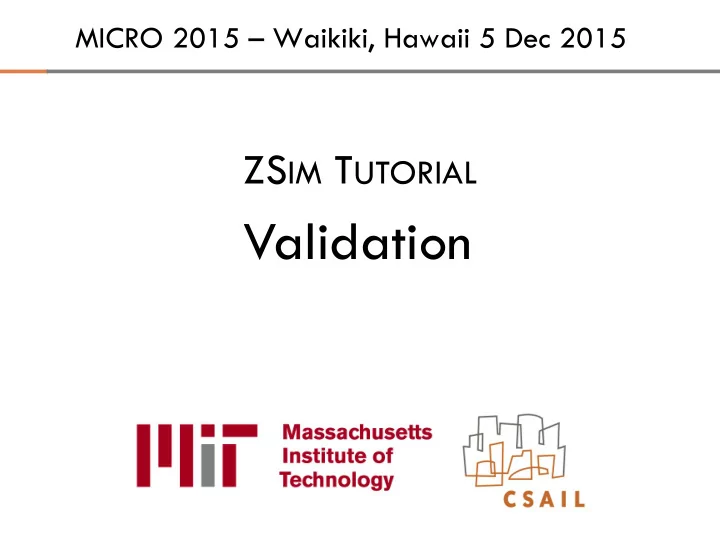

MICRO 2015 – Waikiki, Hawaii 5 Dec 2015 ZS IM T UTORIAL Validation
Outline 2 Introduction Methodology Single-threaded results Multi-threaded results Contention models Conclusion
Introduction 3 How accurate is a simulator? What are the sources of inaccuracies? What kind of workloads and studies is a simulator intended for? Important to do validation before using a simulator. Tony Nowatzki et.al, Architectural Simulators Considered Harmful, IEEE MICRO 2015
Validation in ZSim 4 Micro-benchmarks that stress different micro-architectural structures and events. Ex. Time taken to do integer add, multiply. Lets us catch even minor modeling inaccuracies. Wide range of workloads from different benchmark suites Single threaded – SPECCPU2006 Multi threaded – PARSEC, SPLASH2, SPECOMP 2001
Comparison to other simulators 5 ZSim has an average error of 10% for both single-threaded and multi-threaded workloads. MARSS Cycle accurate OOO x86 model Performance differences range from -59% to 50% with only 5 benchmarks being within 10% Sniper Approximate OOO model Absolute errors over 50% on SPLASH2 benchmarks Graphite, Hornet, SlackSim – no known validation study
Methodology 6 Zsim models an x86 core model. It is possible to validate against real hardware system. We run each application on the real machine and also simulate it on zsim. We record several relevant performance counters on the real machine. Compare them against zsim’s results. We perform multiple profiling and simulation runs to avoid noisy comparisons.
System Configuration 7 We validate ZSim against a Westmere system. Hardware and Software Configuration of the real system and the corresponding ZSim configuration
Single-threaded validation 8 Validate OOO core model with the full SPEC CPU2006 suite. Run each application for 50 billion instructions using ref(largest) input set.
IPC Error 9 Average absolute IPC error is 8.5%. Max error is 26% In 21 out of the 29 benchmarks, error is less than 10%.
MPKI Errors for different caches 10 Average Absolute MPKI errors L1i - 0.32 L1d - 1.14 L2 - 0.59 L3 - 0.30
Traces 11 IPC Trace L3 MPKI Trace
Major sources of error 12 Does not model TLB and page table walkers. Inaccuracies in the front end model. The modeled 2-level branch predictor with an idealized BTB has significant errors in some cases. Most of the errors are observed in benchmarks that have non- negligible TLB misses. It is difficult to figure out the exact details of a processor’s architecture.
µop coverage 13 ZSim implements decoding for the most frequently used op-codes. Only 0.01% of executed instructions have an approximate dataflow decoding Modern compilers only produce a fraction of the x86 ISA. Ignores micro-sequenced instructions. Uop error = (uop real – uop zsim )/uop real Average µop error is 1.3%.
Multithreaded validation 14 22 applications from different benchmark suites 6 from PARSEC, 7 from SPLASH2, 9 from SPEC OMP2001 Run most workloads at 6 threads Those that need power of 2 threads run with 4 threads Measure performance as 1/(time to completion) and not IPC.
Performance errors 15 Average absolute error is 11.2%. 10 out of 23 workloads are within 10% error.
Contention models 16 Many simulators fail to accurately model bandwidth contention. ZSim can accurately simulate a real hardware system by using detailed contention models. We study the scalability of STREAM benchmark on real machine and simulation with several timing models. STREAM saturates memory bandwidth, scaling sub-linearly.
Bandwidth and Scalability 17 Without contention, there is no bandwidth limitation and performance scales linearly. Approximate Queueing theory model(MD1) is still quite inaccurate. Using event-driven model or DRAMSim2 closely approximates real machine.
Accuracy vs Speed 18 Bound-weave algorithm allows for modeling contention at varying degrees of accuracy. Tradeoff between simulation speed and accuracy DRAMSim2 is cycle-accurate – limits ZSim performance to 3 MIPS. Few tens of MIPS with simpler models.
Silvermont validation 19 Changed a few parameters to model a silvermont like core. Absolute performance error of 20.89%. Uop decoding is slightly different. Much simpler branch predictor. We do not model Differences in backend architecture. Silvermont’s prefetcher. Possible to reduce the errors by doing more accurate modelling.
Conclusion 20 You can trust zsim to be quite accurate, but ‘ If you are using zsim with workloads or architectures that are significantly different from ours, you should not blindly trust these results ’ Detailed results available at zsim.csail.mit.edu/validation Plan to release the complete validation infrastructure in future.
THANK YOU Q UESTIONS ?
Recommend
More recommend